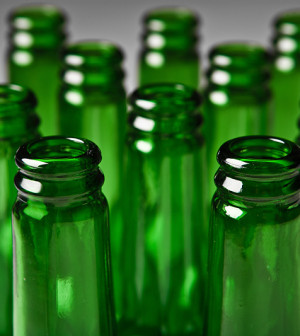- Skip Storing This Everyday Product in the Fridge Door
- Green Tea + B3 Pairing May Boost Brain Health
- Navigating Your Midlife Crisis: Embracing New Possibilities
- City Raccoons Showing Signs of Domestication
- Mapping the Exposome: Science Broadens Focus to Environmental Disease Triggers
- One Week Less on Social Media Linked to Better Mental Health
- Your Brain Changes in Stages as You Age, Study Finds
- Some Suicide Victims Show No Typical Warning Signs, Study Finds
- ByHeart Formula Faces Lawsuits After Babies Sickened With Botulism
- Switch to Vegan Diet Could Cut Your Greenhouse Gas Emissions in Half
Many People Who Drink a Lot Aren’t Alcoholics: CDC


Most people who drink to excess or binge drink are not alcoholics, a new U.S. government report says.
In fact, 90 percent of those who drink too much aren’t dependent on alcohol. But one in three adults drinks to excess, according to the U.S. Centers for Disease Control and Prevention.
“A lot of people mistakenly assume that people who drink too much are alcoholics,” said study co-author Dr. Robert Brewer, the leader of CDC’s alcohol program.
“The surprising finding was that nine out of 10 people who drink too much do not meet the diagnostic criteria for alcoholism,” he said.
Brewer said that some excessive drinkers are “self-medicating.”
“But a lot of it is a reflection of the fact that we live in a society where people get a lot of mixed messages about drinking,” he said. “A lot of people have been led to believe that drinking, and often drinking a large amount, is part of having a good time. What we need to do is change the environment in which people make their drinking decisions.”
According to the report, published Nov. 20 in the CDC journal Preventing Chronic Disease, most excessive drinkers are binge drinkers.
Binge drinking is defined for women as having four or more drinks on an occasion, and for men as having five or more drinks on an occasion. Eight or more drinks a week for women or 15 or more drinks a week for men is considered excessive. Any drinking by pregnant women or those under 21 is also considered excessive, Brewer said.
Alcoholism, however, is a chronic condition that usually includes a history of excessive drinking, a craving for alcohol, continued drinking despite repeated problems with alcohol and being unable to control drinking.
Excessive drinking is responsible for 88,000 deaths each year. About 3,700 alcohol-dependent people die each year, according to the report.
These deaths are caused by the long-term effects of drinking too much, such as breast cancer, liver disease and heart disease. Deaths also occur from the immediate effects of drinking, such as violence, alcohol poisoning and car crashes.
In 2006, the consequences of excessive drinking cost the United States more than $223 billion, Brewer said.
Treatment services are important for alcoholics, Brewer said. “But we need to look at a broader array of interventions that can address excessive drinking in those who are not alcoholics,” he said.
Brewer said strategies to reduce excessive drinking could include increasing the cost of alcohol. “People’s drinking behavior is very responsive to price. If alcohol is more expensive, people tend to drink less,” he said.
Another strategy is to limit the availability of alcohol by strictly controlling where people can buy alcohol, Brewer said.
In addition, doctors should be encouraged to screen their patients for excessive drinking and advise them to drink less, he said.
Dr. Scott Krakower, assistant unit chief of psychiatry at Zucker Hillside Hospital in Glen Oaks, N.Y., said, “Despite all of our awareness and strategies to target alcoholism, we are missing the majority of patients who battle with excessive alcohol consumption or a binge drinking problem.”
Adults and teenagers often underestimate the amount they are drinking and put themselves in dangerous situations when they consume too much alcohol, he said.
“Screening and education are key to helping patients and families understand more about this and how they can stop it. Through these strategies, we can help detect a problem early on and prevent it from worsening,” Krakower said.
For the study, researchers analyzed data on 138,100 U.S. adults aged 18 and older from all 50 states and Washington, D.C., who participated in the National Survey on Drug Use and Health in 2009, 2010 or 2011.
More information
For more information on drinking, visit the U.S. Centers for Disease Control and Prevention.
Source: HealthDay
Copyright © 2025 HealthDay. All rights reserved.










